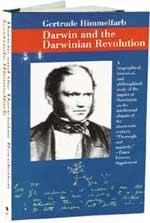
A few months ago The Panda’s Thumb used the occasion of Irving Kristol’s death on September 18th to denigrate Gertrude Himmelfarb’s 50 year-old Darwin and the Darwinian Revolution as a “terrible book . . . demonstrating a lack of understanding of biology and a warped view of Darwin’s influence.” The article, written by Jeffrey Shallit, glibly casts aspersions on the late Kristol’s ethic for reviewing Gertrude Himmelfarb (aka Bea Kristol) in Encounter and failing to disclose that he was the author’s husband (though this writer could find no evidence of that at least with her Darwin), this without once reflecting on the questionable propriety of turning what should have been either a respectful obituary or complete silence into an opportunity to insult both the deceased and his widow. If that isn’t unethical, it is at least indecent. Shallit’s one-sided, high-toned moralizing aside, as the “Darwin year” draws to a close and given the fact that Himmelfarb’s biography of Darwin itself has just marked its golden anniversary, perhaps a careful reflection upon that effort is in order. What can be said of Darwin and the Darwinian Revolution in the dusk of 2009? Is it a terrible book?
Regardless of what one may think of Gertrude Himmelfarb’s work, her preeminent role as an important (albeit controversial) historian cannot be doubted (see Jewish Women: A Comprehensive Historical Encyclopedia). A prolific writer, she has not shrunk from boldly decrying moral relativism and the so-called “new” history, positions for which she earned widespread praise and condemnation. Nevertheless, her serious consideration for the position of Librarian of Congress in 1987 is a measure of her significance as one of America’s leading scholars and intellectuals.
Thus, it would seem worthwhile to probe a bit deeper into Dr. Himmelfarb’sstudy of Charles Darwin. It is worth mentioning that her Darwin biography was (and obviously is) as controversial as its subject. Given the author’s refusal to duck or dodge tough issues, her attention to modern biology’s paterfamilias was bound to form an explosive catalyst easily discerned in the ensuing reviews. Upon its publication Charles Gillispie insisted that “one must deplore the interpretation of Darwin and his work that Miss Himmelfarb offers” for its “hostility to science.”1 Similarly, another reviewer dismissed it as a “misrepresentation” that is “dubious in the extreme.”2 But others saw it differently. J. F. Burnet, for example, praised Darwin and the Darwinian Revolution as “thorough and authoritative,” concluding, “This is an important book for all students of nineteenth-century thought.”3 Another reviewer called it, “a scholarly book, well organized and well written, interesting to the intelligent reader whatever his special field.”4
One would think these reviewers had read entirely different books, and perhaps they did. Himmelfarb’s detractors, as witnessed in Shallit’s mean-spirited post, say little about why her book is terrible, presuming the charge alone is sufficient to indict and convict. Interestingly, Shallit provides “evidence” of the author’s failing in a provocative link tagged <lack of understanding of biology>, which sends one to a posting by PZ Myers on December 6, 2005 titled “A critique of Himmelfarb’s scientific views.” Now Himmelfarb has been caught! The spuriousness of Darwin and the Darwinian Revolution is now laid bare! Well, that’s what The Panda’s Thumb would have you believe anyway.
On closer inspection, however, this “critique” of Himmelfarb’s science is nothing of the kind. In actuality it is a strange diatribe on neoconservativism will allusions to Leo Strauss, George Will, and (Himmelfarb’s husband again) Irving Kristol, none of which has anything whatsoever to do with her purportedly “terrible” science. Stacking up a series of allegedly damning Himmelfarb quotes, Myers then links them to “creationist claims” as if the mere association were sufficient to prove the condemnation. The “critique” concludes with a peculiar discussion of Machiavelli, which not only has nothing to do with Himmelfarb’s science, but indeed nothing to do with neoconservatism (those interested in following the perfidy of Machiavelli should examine number one of Benjamin Wiker’s list of 10 Books That Screwed Up the World).
The only substantive example of Himmelfarb’s supposed lapsed science is Myers’ dismissal of her charge that Darwin failed to explain the evolution of the eye by means of natural selection. Quoting from Ernst Mayr’s What Evolution Is, Myers proclaims the “light-sensitive spot” and the Pax 6 regulatory gene to have solved the problem. “Photosensitive, eyelike organs have developed in the animal series at least 40 times,” declared Salvini and Mayr in 1977, “and all the steps from a light-sensitive to the elaborate eyes of vertebrates . . . are still found in the living species of various taxa.” But 32 years later James Le Fanu (and many others) remain unconvinced. Le Fanu freely admits that “we now know the eye to have emerged independently at least forty times in several different forms,” but this has only served to make Darwin’s evolutionary problem more vexing:
Each different type of eye compounds Darwin’s difficulty further, for then it is necessary to presuppose for each a series of fortuitous “numerous successive slight modifications,” conferring some slight biological advantage to its possessor. It is necessary to presuppose, for, despite much effort, there is not a single empirical discovery in the past 150 years that has substantiated Darwin’s proposal that natural selection, “taking advantage of slight successive variations,” explains the “puzzle of perfection” epitomized by so many different types of eye–which remains yet more puzzling than it was in 1859.5
And Michael Behe notes that the biochemical complexity of vision is not answered by a single regulatory gene, as if a single bolt could explain an automobile. Indeed where might the biochemical evidence lie? Even something as “simple” as a light-sensitive spot is in reality a system requiring a rhodopsin-transducincomplex to interact with phosodiesterase along with many other molecular processes. Moreover, there remains no explanation of how these complex interactions could have occurred by Darwinian processes. “The fossil record,” as Behe has so clearly pointed out, “has nothing to tell us about whether the interactions of 11-cis-retinal with rhodopsin, transducin, and phosphodiesterase could have developed step-by step.”6 No, the problem has not been resolved and is, in fact, worse than when Himmelfarb wrote in 1959 and much worse than when Darwin wrote a century before her.
The poor example of eye evolution apparently exhausts Myers’ evidence against Himmelfarb. The rest of his co-called “critique” is, in fact, an ideological rant rather than a sober investigation of her alleged scientific transgressions. Both Shallit’s and Myers’ remaining appeal seems to be an argumentum ad populum as if scientific truth was decided solely on the basis of consensus. Such arguments, of course, vindicate a “noble” line of scientific “facts” in history like phlogiston, globulism, and humoral pathology. Jeffrey Shallit and PZ Myers are admittedly high on passion but weak on substance.
But Shallit and Myers aren’t the only ones. Besides the Himmelfarb-bashers already mentioned, Ernst Mayr more than a decade after the appearance of her Darwin complained of its “abyss of ignorance and misunderstanding.”7 Even Cornell’s historian of science L. Pearce Williams appreciated Himmelfarb’s grasp of the historical forces bearing upon Darwin and his times but quickly demurred at her assessment of Darwinian evolution. Calling it “filled with rather serious scientific blunders,” even worse than Shallit and Myers, Williams issued the indictment without giving a single instance of said “blunder.”8
Why is Himmelfarb’s Darwin and the Darwinian Revolution the book Darwinists love to hate? To find out, part 2 will offer a detailed examination of the book and its incisive analysis of Darwin’s evolutionary theory. More to follow . . .
__________
References
1Review by Charles C. Gillispie in Isis 51.2 (June 1960): 216.
2Review by Charles F. Mullet in The Journal of Modern History 32.2 (June 1969): 179-180.
3Review by J. F. Burnet in The English Historical Review 76.298 (Jan. 1961): 173-174.
4Review by Francis G. Townsend in The English Journal 48.9 (Dec. 1959): 554.
5James Le Fanu, Why Us? How Science Rediscovered the Mystery of Ourselves (New York: Pantheon Books, 2009), pp. 94-95.
6Michael J. Behe, Darwin’s Black Box: The Biochemical Challenge to Evolution (New York: The Free Press, 1996), p. 22.
7Ernst Mayr, “The Nature of the Darwinian Revolution,” Science (new series) v. 176.4038 (June 2, 1972): 981-989, 987.
8L. Pearce Williams, “The Historiography of Victorian Science,” Victorian Studies 9.3 (March 1966): 197-204, 202.
